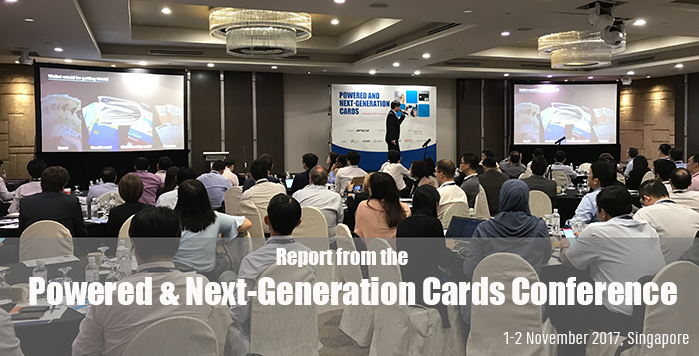|
 |
|


The Powered & Next-Generation Cards conference was organised by APSCA in Singapore on 1-2 November. The first day was attended by payment card industry representatives from Asia and around the world. The second day was a closed-door session for payment card issuers and schemes.

From niche to mainstream products
The conference theme, "Issuing the Payment and Identity Products of Tomorrow", highlighted the fact that these products are the next evolution of the payment and identity card business and that they are no longer a niche product driven only by tech startups.

A new focus on cards
At some point in the future there may be no more payment and identity cards but that date seems to be stretching further into the distance. Industry releases about dCVx cards, biometric cards and other powered card products became common in 2017. Visa's new contactless requirements also hint at a renewed focus on cards. Delegates from 16 markets Delegates from 16 markets
The 136 conference delegates came from 16 markets across Asia, Europe and North America and included both veterans of, and new entrants to, the powered card business. Nearly a quarter of participants were from payment card issuers, domestic and international card schemes and payments services providers.
A powered cards business exchange
Industry representatives came from all sections of the supply chain including specialist powered card component suppliers, companies focused on the challenges of manufacturing processes and equipment for powered cards, integrators of powered card technologies and leading card and chip solutions providers now targeting the new powered cards business segment.
 PHOTOS FROM THE CONFERENCE: Check out photo highlights from the conference HERE PHOTOS FROM THE CONFERENCE: Check out photo highlights from the conference HERE 
- Today many payment card industry participants are still focused on the selling price of powered cards rather than the significantly enhanced top-of-wallet value that they can offer to issuers over that of standard EMV dual-interface payment cards.
- Industry participants were sharply divided between those who do not see an ASP of US$30 or above as a challenge, because they understand that there is a market for such products that offer real value to issuers, and those who seem to want ASPs to fall to those of standard EMV cards today.
- Companies that have already sold powered card products to issuers explained that despite the significantly higher ASPs the issuers achieved real quantifiable benefits including greater revenues from increased numbers of transactions and from acquiring new customers.
- Participants that were issuers agreed that for premium powered credit card products that offer such benefits over and above standard credit card products in the market, that the cost of the card would not be the sole consideration.
- Powered cards represent the first significant innovation in the payment and identity card market for a long time. Chip cards, including contactless cards, have changed little over the last 20 years; during the same time the Internet, smart phones and even IOT solutions have become commonplace.
- The industry now has the choice of offering standard EMV contactless payment cards, a commodity whose value is reflected in ASPs below US$1, or offering powered next-generation cards at much higher prices which reflect the much greater value that they can deliver to customers.
- Go-to-market strategies for powered cards require new approaches focusing on payment and identity solutions, offering benefits not available from existing commodity card products, and using innovative business models that may involve the cardholder buying or renting the solution.
- Communicating the benefits of powered cards is a sales task that requires helping customers understand the potential for creating value from innovative solutions. Account managers focused on commodity cards and lowest possible ASPs are less likely to be successful in the next-generation cards business.
- While growing the market, companies in the powered cards business need to be mindful of production ability to meet market demand. If the powered cards market expands too quickly then the supply chain today may not be able to ramp up manufacturing volumes to match demand.
- There are still challenges with manufacturing powered cards that have not yet been completely solved. Today it would be difficult or impossible to manufacture powered cards in the same volumes as the commoditized EMV contactless cards that customers are issuing all over the world.
- The biggest challenge is the development of encapsulation technologies that can package flexible PCBs and powered card components into a standard 7816-size card body, under volume manufacturing processes at acceptable yields. There may only be one company with this capability today.
- Innovations that can reduce the size of flexible PCB systems and powered card components will not only reduce costs but also enable new manufacturing techniques and processes that should enable higher volume manufacturing with higher yields.
|
Powered & Next-Generation Cards 2018 To find out about APSCA's 2018 Powered & Next-Generation Cards conference and exhibition, please contact Elaine Li at elaine.li@apsca.org
If you are attending Trustech 2017 next week then contact us (elaine.li@apsca.org) to arrange a meeting with APSCA Chairman Greg Pote at the exhibition.
|
|
 |
|
|



